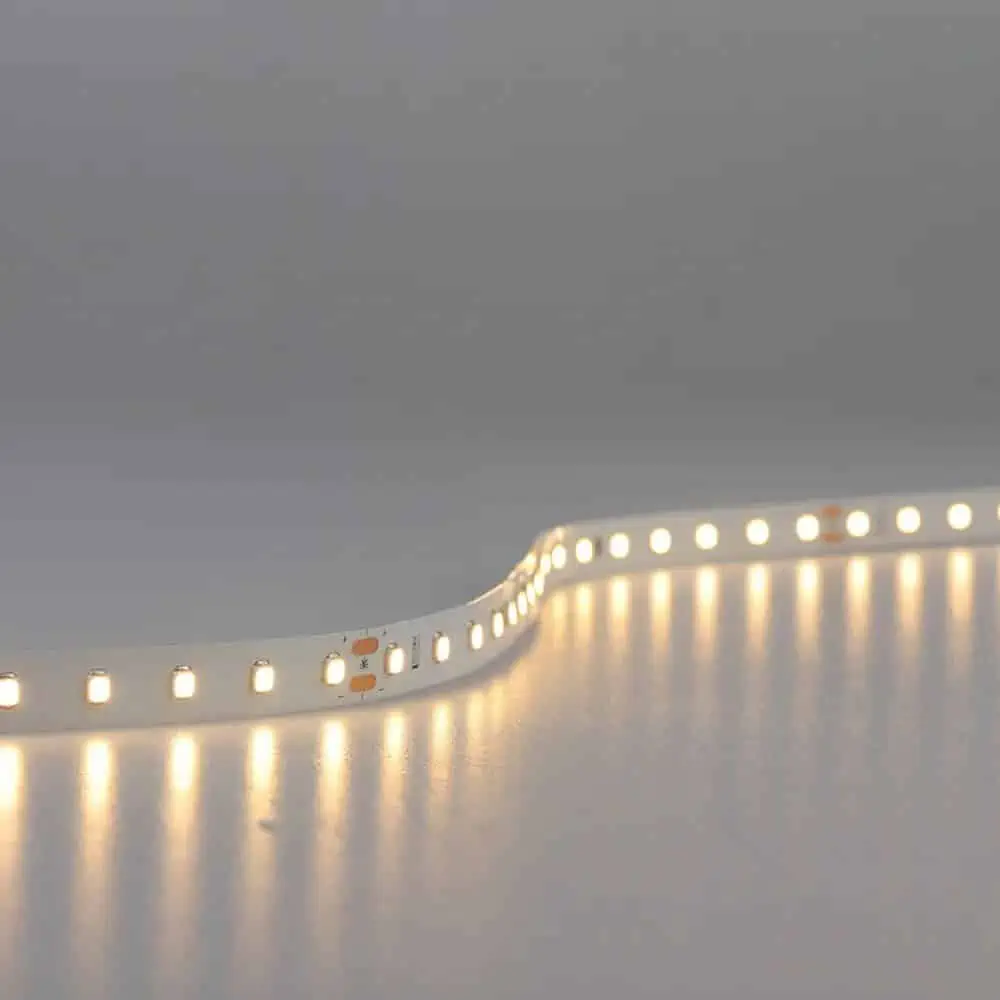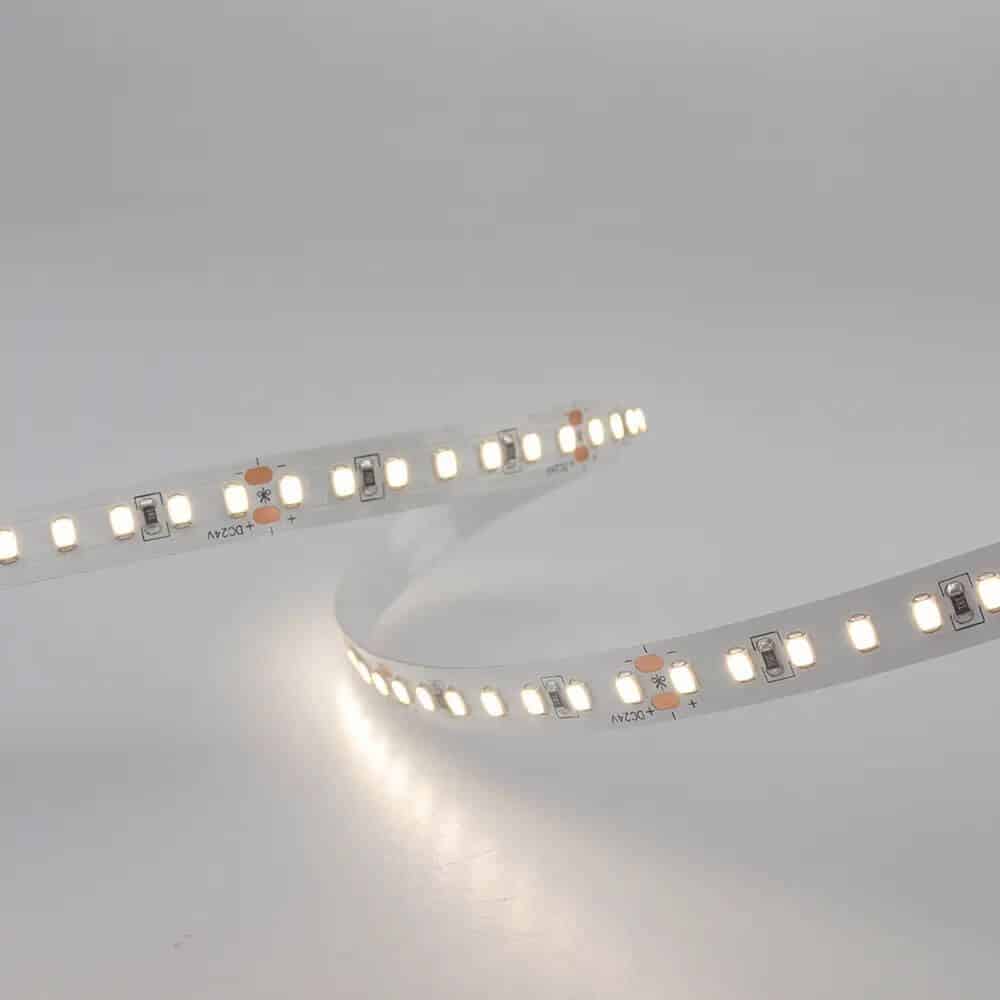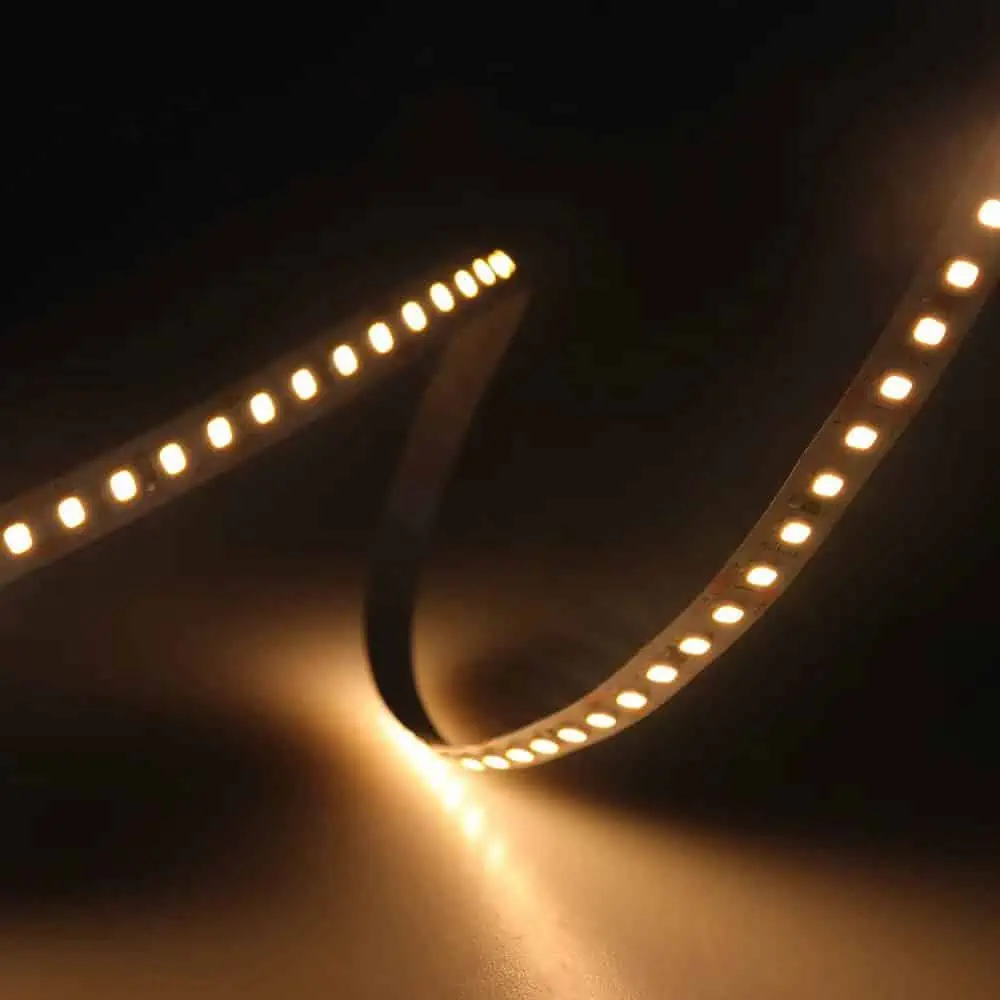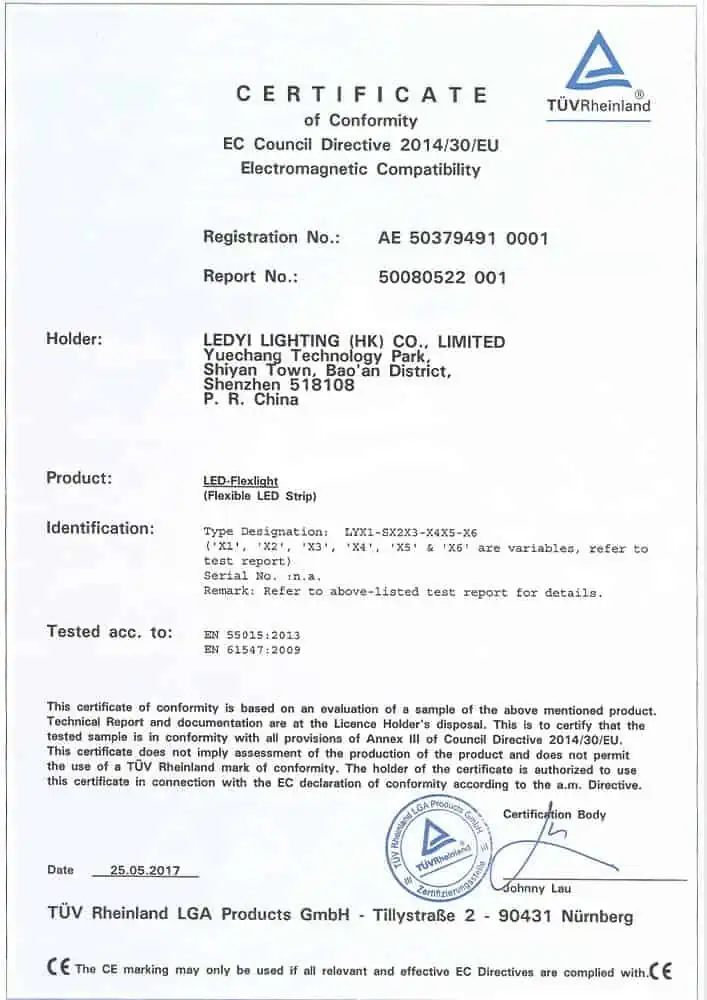New ErP Regulation LED Strip
- Various energy efficiency class available: C / D / E / F / G
- Various power available: 4.5W/m, 4.8W/m, 9W/m, 9.6W/m, 14.4W/m, 19.2W/m
- Various LED density available: From 70LEDs/m to 240LEDs/m, and COB(Dot-free)
- Static White and Tunable White are available
- CRI80 or CRI90 are available
- Silicone extrusion waterproof process, IP52/IP65/IP67 available
- OEM and ODM are welcome
- 5 years warranty
What is The New ErP Regulations?
ErP is the abbreviation of Energy-related Products. It also refers to Energy-related Products Directive (ErP) 2009/125/EC that replaced the old Energy-using Products Directive (EuP) in November 2009. The original EuP was taken into use in 2005 to fulfill the Kioto agreement requirements for reducing carbon dioxide emissions.
The ErP broadened the range of products that were covered in EuP. Earlier only directly energy-consuming (or using) products were covered. Now ErP directive also covers the products related to energy. This could be for example water-saving taps, etc.
The idea is to cover the whole product supply chain: design stage, production, transport, packaging, storage, etc.
The former ErP directives EC 244/2009, EC 245/2009, EU 1194/2012 and Energy Label directive EU 874/2012 had been taken effect for more than10 years. Recently, the European Commission has reviewed these regulations and analyzed the technical, environmental and economic aspects of lighting products as well as real-life user behavior and issued new ErP directives EU 2019/2020 and energy label directive EU 2019/2015.
What Does The New ErP Regulation Contain?
- EU SLR – Single Lighting Regulation | Commission Regulation (EU) No 2019/2020 laying down ecodesign requirements for light sources and separate control gear. You can read the SLR in full here.
- EU ELR – Energy Labelling Regulation | Commission Regulation (EU) No 2019/2015 laying down energy labelling requirements of light sources. You can read the ELR in full here.
The SLR will replace and repeal three regulations: (EC) No 244/2009, (EC) No 245/2009, and (EU) No 1194/2012. This will give a single reference point for compliance, define the light sources covered under the regulation, and separate control gear in new terms. Light sources can be anything that emits white lights, including LED lamps, LED modules, and luminaires. Luminaires can also be classified as containing products for light sources.
The new, more stringent minimum efficacy thresholds on light sources and separate control gear should encourage the lighting industry to innovate and further improve energy efficiency beyond existing technology.
It also encourages design for a circular economy with more reuse and less refuse. This means products should be designed to be more reliable, upgradeable where possible, enable the ‘right to repair’, contain more recyclable material, and be easier to dismantle. This will ultimately help to reduce waste ending up in a landfill.
Energy Labels are the tool used to communicate energy efficiency. They are used on all electrical energy-using products, including washing machines, televisions, and light sources.
Regulations are a tool used to implement the requirements for improving efficiency.
The ELR will replace and repeal two regulations: (EC) No 874/2012 and (EC) No 2017/1369.
It defines the new energy labelling requirements for packaging, sales literature, websites, and distance selling. As part of this, all products requiring energy labels must be registered into the EPREL database. A QR code linking to the technical product information is also mandatory.
When Will The New ErP Regulation Be Implemented?
Single Lighting Regulation | Commission Regulation (EU) No 2019/2020
Effective date: 2019/12/25
Implementation date: 2021/9/1
Old regulations and their expiration dates: (EC) 244/2009, (EC) 245/2009 & (EU) 1194/2012 expires from 2021.09.01
Energy Labelling Regulation | Commission Regulation (EU) No 2019/2015
Effective date: 2019/12/25
Implementation date: 2021/9/1
Old regulations and their expiration dates: (EU) No 874/2012 was invalid from 2021.09.01, but the clauses on the energy efficiency label of lamps and lanterns was invalid from 2019.12.25

Subject Matter And Scope of New ErP Regulation
1. This Regulation establishes ecodesign requirements for the placing on the market of
(a) light sources;
(b) separate control gears.
The requirements also apply to light sources and separate control gears placed on the market in a containing product.
2. This Regulation shall not apply to light sources and separate control gears specified in points 1 and 2 of Annex III.
3. Light sources and separate control gears specified in point 3 of Annex III shall comply only with the requirements of point 3(e) of Annex II.
Please click here for more details.
Ecodesign Requirements
For the purposes of compliance and verification of compliance with the requirements of this Regulation, measurements and calculations shall be made using harmonised standards the reference numbers of which have been published for this purpose in the Official Journal of the European Union, or other reliable, accurate and reproducible methods, which take into account the generally recognised state-of-the-art.
(a) | From 1 September 2021, the declared power consumption of a light source P on shall not exceed the maximum allowed power Ponmax (in W), defined as a function of the declared useful luminous flux Φuse (in lm) and the declared colour rendering index CRI (-) as follows: Ponmax = C × (L + Φuse/(F × η)) × R; where:
Table 1 Threshold efficacy (η) and end loss factor (L)
Table 2 Correction factor C depending on light source characteristics
Where applicable, bonuses on correction factor C are cumulative. The bonus for HLLS shall not be combined with the basic C-value for DLS (basic C-value for NDLS shall be used for HLLS). Light sources that allow the end-user to adapt the spectrum and/or the beam angle of the emitted light, thus changing the values for useful luminous flux, colour rendering index (CRI) and/or correlated colour temperature (CCT), and/or changing the directional/non-directional status of the light source, shall be evaluated using the reference control settings. The standby power Psb of a light source shall not exceed 0,5 W. The networked standby power Pnet of a connected light source shall not exceed 0,5 W. The allowable values for Psb and Pnet shall not be added together. |
(b) | From 1 September 2021, the values set in Table 3 for the minimum energy efficiency requirements of a separate control gear operating at full-load shall apply: Table 3 Minimum energy efficiency for separate control gear at full-load
Multi-wattage separate control gears shall comply with the requirements in Table 3 according to the maximum declared power on which they can operate. The no-load power Pno of a separate control gear shall not exceed 0,5 W. This applies only to separate control gear for which the manufacturer or importer has declared in the technical documentation that it has been designed for no-load mode. The standby power Psb of a separate control gear shall not exceed 0,5 W. The networked standby power Pnet of a connected separate control gear shall not exceed 0,5 W. The allowable values for Psb and Pnet shall not be added together. |
From 1 September 2021, the functional requirements specified in Table 4 shall apply for light sources:
Table 4
Functional requirements for light sources
Colour rendering | CRI ≥ 80 (except for HID with Φuse > 4 klm and for light sources intended for use in outdoor applications, industrial applications or other applications where lighting standards allow a CRI< 80, when a clear indication to this effect is shown on the light source packaging and in all relevant printed and electronic documentation) |
Displacement factor (DF, cos φ1) at power input Pon for LED and OLED MLS | No limit at Pon ≤ 5 W, DF ≥ 0,5 at 5 W < Pon ≤ 10 W, DF ≥ 0,7 at 10 W < Pon ≤ 25 W DF ≥ 0,9 at 25 W < Pon |
Lumen maintenance factor (for LED and OLED) | The lumen maintenance factor XLMF% after endurance testing according to Annex V shall be at least XLMF,MIN % calculated as follows:
where L70 is the declared L70B50 lifetime (in hours) If the calculated value for XLMF,MIN exceeds 96,0 %, an XLMF,MIN value of 96,0 % shall be used |
Survival factor (for LED and OLED) | Light sources should be operational as specified in row ‘Survival factor (for LED and OLED)’ of Annex IV, Table 6, following the endurance testing given in Annex V. |
Colour consistency for LED and OLED light sources | Variation of chromaticity coordinates within a six-step MacAdam ellipse or less. |
Flicker for LED and OLED MLS | Pst LM ≤ 1,0 at full-load |
Stroboscopic effect for LED and OLED MLS | SVM ≤ 0,4 at full-load (except for HID with Φuse > 4 klm and for light sources intended for use in outdoor applications, industrial applications or other applications where lighting standards allow a CRI< 80) |
3. Information requirements
From 1 September 2021 the following information requirements shall apply:
(a) | Information to be displayed on the light source itself For all light sources, except CTLS, LFL, CFLni, other FL, and HID, the value and physical unit of the useful luminous flux (lm) and correlated colour temperature (K) shall be displayed in a legible font on the surface if, after the inclusion of safety-related information, there is sufficient space available for it without unduly obstructing the light emission. For directional light sources, the beam angle (°) shall also be indicated. If there is room for only two values, the useful luminous flux and the correlated colour temperature shall be displayed. If there is room for only one value, the useful luminous flux shall be displayed. |
(b) | Information to be visibly displayed on the packaging
|
(c) | Information to be visibly displayed on a free-access website of the manufacturer, importer or authorised representative
|
(d) | Technical documentation
|
(e) | Information for products specified in point 3 of Annex III For the light sources and separate control gears specified in point 3 of Annex III the intended purpose shall be stated in the technical documentation for compliance assessment as per Article 5 of this Regulation and on all forms of packaging, product information and advertisement, together with an explicit indication that the light source or separate control gear is not intended for use in other applications. The technical documentation file drawn up for the purposes of conformity assessment, in accordance with Article 5 of this Regulation shall list the technical parameters that make the product design specific to qualify for the exemption. In particular for light sources indicated in point 3(p) of Annex III it shall be stated: ‘This light source is only for use by photo sensitive patients. Use of this light source will lead to increased energy cost compared to an equivalent more energy efficient product.’ |
Please click here for more detail information.
Energy Labelling Requirements
1. LABEL
If the light source is intended to be marketed through a point of sale, a label produced in the format and containing information as set out in this Annex is printed on the individual packaging.
Suppliers shall choose a label format between point 1.1 and point 1.2 of this Annex.
The label shall be:
— | for the standard-sized label at least 36 mm wide and 75 mm high; |
— | for the small-sized label (width less than 36 mm) at least 20 mm wide and 54 mm high. |
The packaging shall not be smaller than 20 mm wide and 54 mm high.
Where the label is printed in a larger format, its content shall nevertheless remain proportionate to the specifications above. The small-sized label shall not be used on packaging with a width of 36 mm or more.
The label and the arrow indicating the energy efficiency class may be printed in monochrome as specified in points 1.1 and 1.2, only if all other information, including graphics, on the packaging is printed in monochrome.
If the label is not printed on the part of the packaging meant to face the prospective customer, an arrow containing the letter of the energy efficiency class shall be displayed as hereafter, with the colour of the arrow matching the letter and the colour of the energy class. The size shall be such that the label is clearly visible and legible. The letter in the energy efficiency class arrow shall be Calibri Bold and positioned in the centre of the rectangular part of the arrow, with a border of 0,5 pt in 100 % black placed around the arrow and the letter of the efficiency class.
Figure 1
Coloured/monochrome left/right arrow for the part of the packaging facing the prospective customer

In the case referred to in point (e) of Article 4 the rescaled label shall have a format and size that permits it to cover and adhere to the old label.
1.1. Standard-sized label:
The label shall be:

1.2. Small-sized label:
The label shall be:

1.3. The following information shall be included in the label for light sources:
I. | supplier’s name or trade mark; |
II. | supplier’s model identifier; |
III. | scale of energy efficiency classes from A to G; |
IV. | the energy consumption, expressed in kWh of electricity consumption per 1 000 hours, of the light source in on-mode; |
V. | QR-code; |
VI. | the energy efficiency class in accordance with Annex II; |
VII. | the number of this Regulation that is ‘2019/2015’. |
2. LABEL DESIGNS
2.1. Standard-sized label:

2.2. Small-sized label:

2.3. Whereby:
(a) | The dimensions and specifications of the elements constituting the labels shall be as indicated in paragraph 1 of Annex III and in the label designs for standard-sized and small sized labels for light sources. |
(b) | The background of the label shall be 100 % white. |
(c) | The typefaces shall be Verdana and Calibri. |
(d) | Colours shall be CMYK – cyan, magenta, yellow and black, following this example: 0-70-100-0: 0 % cyan, 70 % magenta, 100 % yellow, 0 % black. |
(e) | The labels shall fulfil all the following requirements (numbers refer to the figures above):
|
1. Product information sheet
1.1. | Pursuant to point 1(b) of Article 3, the supplier shall enter into the product database the information as set out in Table 3, including when the light source is a part in a containing product. Table 3 Product information sheet
Table 4 Reference luminous flux for equivalence claims
Table 5 Multiplication factors for lumen maintenance
Table 6 Multiplication factors for LED light sources
Table 7 Equivalence claims for non-directional light sources
Table 8 Minimum efficacy values for T8 and T5 light sources
For light sources that can be tuned to emit light at full-load with different characteristics, the values of parameters that vary with these characteristics shall be reported at the reference control settings. If the light source is no longer placed on the EU market, the supplier shall put in the product database the date (month, year) when the placing on the EU market stopped. | |||||||||||||||||||||||||||||||||||||||||||||||||||||||||||||||||||||||||||||||||||||||||||||||||||||||||||||||||||||||||||||||||||||||||||||||||||||||||||||||||||||||||||||||||||||||||||||||||||||||||||||||||||||||||||||||||||||||||||||||||||||||||||||||||||||||||||||||||||||||||||||||||||||||||||||||||||||||||||||||||||||||||||||||||||||||||||||||||||||||||||||||||||||||||||
2. Information to be displayed in the documentation for a containing product
If a light source is placed on the market as a part in a containing product, the technical documentation for the containing product shall clearly identify the contained light source(s), including the energy efficiency class.
If a light source is placed on the market as a part in a containing product, the following text shall be displayed, clearly legible, in the user manual or booklet of instructions:
‘This product contains a light source of energy efficiency class <X>’,
where <X> shall be replaced by the energy efficiency class of the contained light source.
If the product contains more than one light source, the sentence can be in the plural, or repeated per light source, as suitable.
3. Information to be displayed on the supplier’s free access website:
(a) | The reference control settings, and instructions on how they can be implemented, where applicable; |
(b) | Instructions on how to remove lighting control parts and/or non-lighting parts, if any, or how to switch them off or minimize their power consumption; |
(c) | If the light source is dimmable: a list of dimmers it is compatible with, and the light source — dimmer compatibility standard(s) it is compliant with, if any; |
(d) | If the light source contains mercury: instructions on how to clean up the debris in case of accidental breakage; |
(e) | Recommendations on how to dispose of the light source at the end of its life in line with Directive 2012/19/EU of the European Parliament and of the Council (1). |
4. Information for products specified in point 3 of Annex IV
For the light sources specified in point 3 of Annex IV, their intended use shall be stated on all forms of packaging, product information and advertisement, together with a clear indication that the light source is not intended for use in other applications.
The technical documentation file drawn up for the purposes of conformity assessment, in accordance with paragraph 3 of Article 3 of Regulation (EU) 2017/1369 shall list the technical parameters that make the product design specific to qualify for the exemption.
Please click here for more detail information.
Energy Efficiency Classes And Calculation Method
The energy efficiency class of light sources shall be determined as set out in Table 1, on the basis of the total mains efficacy ηTM, which is calculated by dividing the declared useful luminous flux Φuse (expressed in lm) by the declared on-mode power consumption Pon (expressed in W) and multiplying by the applicable factor FTM of Table 2, as follows:
ηTM = (Φuse/Pon) × FTM (lm/W).
Table 1
Energy efficiency classes of light sources
Energy efficiency class | Total mains efficacy ηΤM (lm/W) |
A | 210 ≤ ηΤM |
B | 185 ≤ ηΤM < 210 |
C | 160 ≤ ηΤM < 185 |
D | 135 ≤ ηΤM < 160 |
E | 110 ≤ ηΤM < 135 |
F | 85 ≤ ηΤM < 110 |
G | ηΤM < 85 |
Table 2
Factors FTM by light source type
Light source type | Factor FTM |
Non-directional (NDLS) operating on mains (MLS) | 1,000 |
Non-directional (NDLS) not operating on mains (NMLS) | 0,926 |
Directional (DLS) operating on mains (MLS) | 1,176 |
Directional (DLS) not operating on mains (NMLS) | 1,089 |

EPREL: What Lighting Businesses Need To Know
Working with new energy labelling is now unavoidable for the lighting industry, so it’s worth familiarising yourself with its standard requirements for its use.
- New energy labels cannot be publicised prior to 1st of September 2021
- ALL applicable products, either on the market or intended to be placed onto the market, must be registered in the EPREL database if intended for the EU marketplace
- ALL applicable products, either on the market or intended to be placed onto the market, must have the new energy rating label, suitable for the EU market and/or UK market
- Energy Related Products (ERP) must be compliant to their respective efficiency regulations – for lighting – if it’s in scope – that’s the SLR.
- As of 1st September, 2021, ONLY SLR compliant products can be placed on the market, or if already placed on the market they may continue to be saleable.
- Data within the EPREL database must be fully complete in order for the item to be published as live – and therefore considered saleable.
- Products on the market with incomplete EPREL registrations will be deemed non-compliant by market surveillance.
LED Strips Compliant With New ErP Regulations
LEDYi are ready and have developed a range of LED strips that comply with the new ErP regulation, and they have a luminous efficiency of up to 184LM/W, and its energy efficiency class is C. By using the solid slicone extrusion process, the ErP led strip can be IP52, IP65, IP67. Please see the product range below:

New ErP LED Strip IP20/IP65 Series

New ErP LED Strip IP52/IP67C/IP67 Series

Specification (New ErP LED Strip IP20/IP65 Series)
4.5W/4.8W CRI90 IP20/IP65 Series
9W/9.6W CRI90 IP20/IP65 Series
14.4W CRI90 IP20/IP65 Series
Tunable White CRI90 IP20/IP65 Series
Specification (New ErP LED Strip IP52/IP67C/IP67 Series)
Tunable White CRI90 IP52/IP67C/IP67 Series
Test Report (New ErP LED Strip IP20/IP65 Series)
4.5W/4.8W CRI90 IP20/IP65 Series
9W/9.6W CRI90 IP20/IP65 Series
14.4W CRI90 IP20/IP65 Series
19.2W CRI90 IP20/IP65 Series
Tunable White CRI90 IP20/IP65 Series
Test Report (New ErP LED Strip IP52/IP67C/IP67 Series)
9.6W CRI90 IP52/IP67C/IP67 Series
Tunable White CRI90 IP52/IP67C/IP67 Series
Product Testing
All of our new ErP directive led strip lights are not mass-produced until they have gone through multiple rigorous testing steps in our laboratory equipment. This ensures high performance and stability and the product’s long life.
Certification
We always strive to provide our customers with the best possible customer experience when working with us. In addition to our excellent customer service, we want our customers to be confident that their new ErP directive led tape lights are safe and of the highest quality. To ensure the best performance, all our new ErP led tape lights have passed CE, RoHS certificates.
Why Wholesale New ErP regulations From LEDYi
LEDYi is one of the leading led strip lights manufacturers in China. We supply popular new ErP directive led tape lights such as smd2835 led strip, smd2010 led strip, cob led strip, smd1808 led strip and led neon flex, etc. for high efficiency and low cost. All our LED strip lights are CE, RoHS certificated, ensuring high performance and a long lifetime. We offer customized solutions, OEM, ODM service. Wholesalers, distributors, dealers, traders, agents are welcome to purchase in bulk with us.


























































